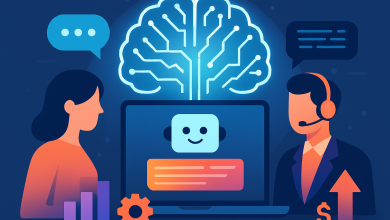
Why creators and marketers should treat AI as a backstage tool rather than a forward-facing figure to connect with audiences.
The internet is no stranger to fads, but few have gained traction with the speed and intensity of what some are now calling “AI asset farming.” This emerging practice—where content creators automate the production of short-form videos, voiceovers and animations using generative AI tools—has taken hold across platforms like YouTube, TikTok and Instagram. As a result, some channels and creators are churning out dozens of clips a day, but there’s a catch. In this content, the narration is often synthetic, visual imagery is templated and the face of the creator rarely appears, if at all.
This is the new frontier of creator-led automation: fast, cheap, and largely anonymous. With just a few prompts, users can generate hours of content through a series of simple clicks. The result? Digital avatars might explain personal finance while AI-cloned voices narrate travel hacks to audiences. Clips are then repackaged, republished and retargeted for maximum exposure.
At first glance, the trend appears rational. Technology is closing the gap between ambition and execution, enabling greater output. One-person operations can now mimic the scale of what large teams develop in media studios. Yet beneath the promise of efficiency lies a more precarious truth: in the race to optimize, many are eroding the very ingredient that gives content its commercial power—human trust.
Faceless scale, featureless results
The rise of faceless automation coincides with a broader collapse of friction in the content economy. Video editing, once a skill, is now a filter. Voiceovers, once recorded, are now automatically generated. The marginal cost of a new post approaches zero. In economic terms, this system is efficient but in human terms, it is becoming increasingly hollow.
Audiences are noticing. While some AI-generated channels have amassed large followings, engagement metrics often decline over time. In many cases, the content is consumed but not remembered, as viewers quickly scroll through their social media feeds stop. For example, an AI avatar may explain “How to Retire Early,” but rarely does the viewer follow them to a second video, let alone trust them with financial advice.
This is not a failure of quality. Some AI tools now rival human craftsmanship in tone, tempo and texture. The issue is not production value, but credibility. Viewers, particularly younger ones, are growing adept at identifying what is real and what is not. While they may tolerate synthetic entertainment in the short-term, they are markedly less inclined to trust it for the long-haul.
People trust people, not prompts
Creators and marketers need to make a clear distinction between performance and persuasion. Trust is not a feature one can simply append to a video. A creator who appears on camera, speaks in their own voice and shares a lived perspective—even if imperfect—typically earns more trust than a faceless narrator with a flawless script.
Consider recent shifts in advertising. Traditional campaigns featuring polished spokespeople or celebrity campaigns have steadily ceded ground to creator-led narratives. Product launches now come via TikTokers, not television actors. The most successful brand campaigns are often those where the product is secondary to the story: a creator walking their dog, preparing a meal, or sharing a financial mistake. In these formats, the commercial message is absorbed not through persuasion, but proximity. It feels like a recommendation, not a pitch.
The trust curve flattens with audiences
The irony of faceless content is that its very strength—frictionless scale—is also its greatest weakness. The absence of a real person behind the message invites a quiet skepticism with audiences, flattening the trust curve.
This trust gap has commercial implications. Brands that rely on content to drive customer acquisition in e-commerce, membership or lead generation face a hard truth: people buy from people, not AI. Even in the most rational of categories (insurance, finance, health), conversion rates consistently rise when content is delivered by someone viewers can identify, relate to or remember.
It is no accident that some of the highest-performing digital campaigns today feature creators with modest followings but deep credibility. A mother discussing children’s vitamins. A veteran describing mortgage assistance. A teacher reviewing productivity tools. These are believable human beings with relevant expertise, and in a saturated market, believability often outperforms brilliance.
AI belongs behind the curtain
This is not an argument against artificial intelligence. Rather, the more urgent task is to reorient where, how and why AI is used in content strategy.
When used properly, AI is a force multiplier. It can refine scripts, identify optimal thumbnails, summarize long-form interviews and even test variations of ad copy in real time. It can ensure content complies with platform policies or internal brand standards. In short, AI can help creators move faster, safer and smarter all while remaining behind-the-scenes.
Only when AI replaces the face, voice or persona of the creator does it run the risk undermining authenticity and human connection. But when it supports the creator invisibly, the effect can be transformative. The content remains human and the delivery becomes sharper.
The future is more human, not less
The popularity of AI asset farming will likely continue, at least in the short term. However, its long-term viability as a strategy for creators or marketers remains dubious. Content may be easy to generate but trust, the most sought-after asset in marketing, remains stubbornly hard to scale.
For those seeking to build lasting audiences or businesses, the path forward is not automation in front of the camera, but authenticity behind it. Use AI to polish and enhance the story—not to erase the storyteller.
In an era where anyone can say anything, audiences are asking one quiet question: who is this coming from? The creators who can answer that honestly will be the ones audiences remember.





